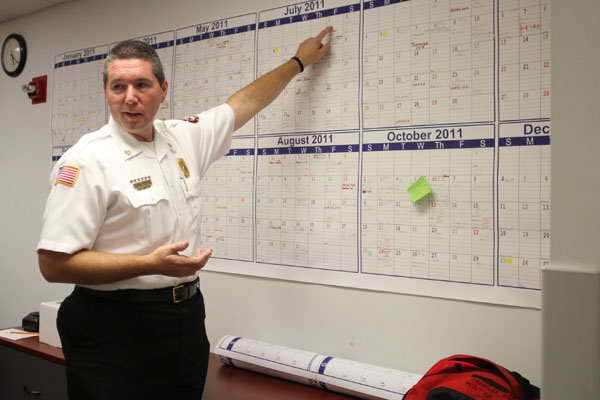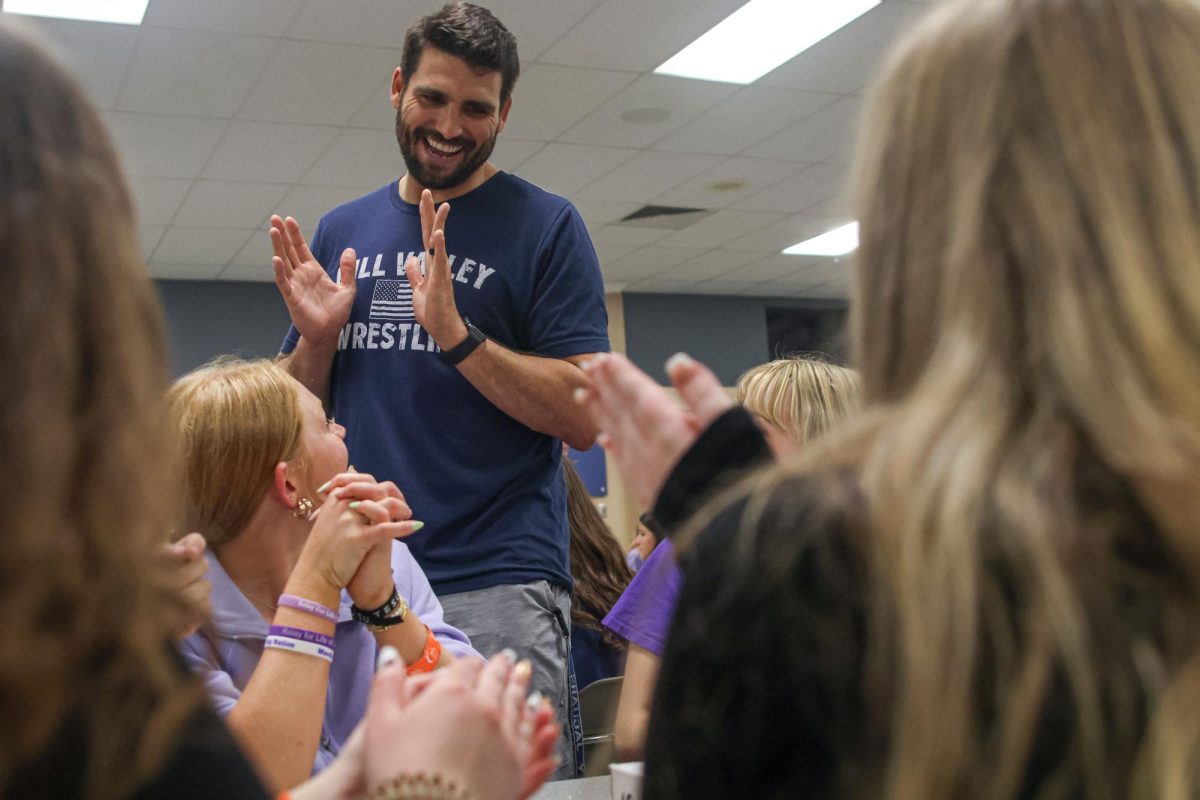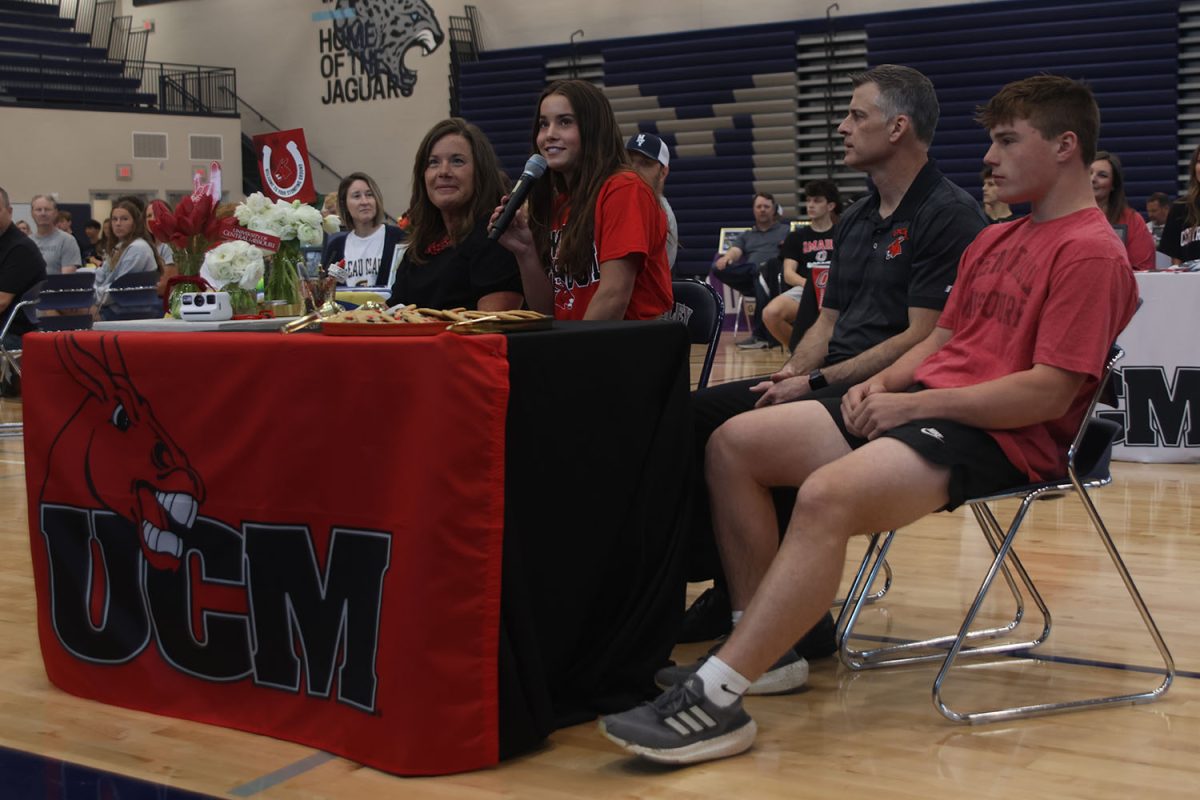Empty shelves fill the office that acting fire chief John Mattox is still moving into on Tuesday, Oct. 11. After 32 years on the job, Mattox was promoted to acting fire chief following former fire chief Jeff Hudson’s retirement in September.
“I’ve been trapped one time in a fire,” acting fire chief John Mattox said. “…The guy I was with and I knew we needed to get out, so we followed our hose line back and pulled up nothing…I burned my ears and hand and ruined my gear…I’ve had walls fall on me and bumps and scrapes and there’s probably [been] some [fires] I should have been afraid in and wasn’t.”
Mattox’s dream of becoming a firefighter began when he was very young. His father was a volunteer firefighter and at 17, when he was just barely younger than the required 18 years for the job, Mattox and five of his childhood friends joined the department.
Mattox was a volunteer in Edwardsville, Kan. for seven years, a full-time firefighter for the city in 1984, captain for the city in 1986 and assistant chief for the city starting in 2000 until he moved to Shawnee in 2001. Mattox started his career in Shawnee as a fire marshal until 2008 when that position was renamed to deputy chief/fire marshal. Now he fills the position of acting fire chief and has made his desire to become the permanent fire chief known.
Mattox had no desire for the position until Hudson put in a word with him.
“Through his urging and coaxing and some of his talks, I thought, ‘I could do this,’ and I asked him what I could do to prepare myself,” Mattox said.
“I told myself this is a young person’s job and I didn’t want to be climbing on a fire truck when I’m 50 and I’ve met that goal, I’ll be 50 next week,” Mattox said.
Mattox doesn’t consider his job “work.”
“We’re all just big kids because we like the big red trucks and the flashing lights,” Mattox said.
As he finishes his sentence, a knock at the window makes him get up. He comes back carrying a plate of desserts. Once a week, sometimes two to three times a week, people bring fruit trays, pies, cakes, donuts and more to the station. The reasoning for the food is always the same: just to say thanks.
The city receives about 4,500 calls a year and about 15 calls a day, distributed between four city crews. Mattox estimates that about one fourth of those calls are life-threatening. Last year, response time to fires averaged four minutes and 25 seconds from the time the fire alarm rings in the station to the crew’s arrival at the emergency. This year, that time has been reduced to four minutes and 21 seconds.
Today, Mattox’s job doesn’t involve these calls but rather mainly administrative, budget and personnel coordination responsibilities as well as management of the department. However, a change in job title has not removed him from the atmosphere his crew still works in. Although Mattox does not oversee day-to-day operations, he is still present to see much of a typical shift.
Every day, a new shift arrives at the station at 7 a.m. and will not leave for another 24 hours. Firefighters keep fire trucks clean and working, participate in job training, eat, work out and some even study for higher educational degrees all while they are on-call in the station.
Battalion chief Mike Beatty is one such person who has been exposed to wide variety of duties a firefighter experiences.
“I don’t know if I’ve actually delivered a baby, but I’ve been right there,” Beatty said. “There’s been a lot of CPR where we’ve been pumping and they’ll wake up and say ‘What are you doing?’”
Beatty also grew up in the fire station. His dad, grandfather, great grandfather and uncle were all firefighters.
“My mom used to drop me off at the fire station on weekends and leave,” Beatty said.
As Beatty sits propped in a fire truck, the sounds of the just-dispatched crew can still be heard in the distance. Mattox stands nearby as they both watch the crew leave to help fight a fire in Olathe. Smoke from a fire in a parking garage can be seen over the station.
“You saw how we were back there cooking dinner and now these guys are out,” Beatty said. “Out there is what we live for.”
Every day, crews can expect to fight fires, but May 22, 2010, stands out for Beatty.
“We were here eating dinner and we had a house fire and we came back a couple of hours later without a guy,” Beatty, who was on-duty that night said. “It was very somber.”
That night, 33-year-old firefighter John Glaser was killed in the line of duty after he was separated from his crew and overcome with smoke in a structural fire. Glaser left behind his wife and 3-year-old-son and 18-month-old daughter.
Mattox wasn’t on-duty that night, but he felt the effects of the tragedy.
“It was a very emotional time for everybody but it brought out the best in everybody,” Mattox said. “It raised everybody’s awareness. I don’t know any firefighters that go through this expecting this to happen to them. You read about it, you see it on the news, but in the back of your mind it’s not going to happen to you.”
Every crew in the city has a picture of Glaser in their station to honor his memory. At the Quivira Road station, where Mattox works and where Glaser worked as well, that same picture is decorated with University of Kansas ribbons to remember him by his favorite sports team.
Glaser’s locker still contains all of his gear and has been encased with diamond plate and decorated with KU memorabilia. The protector memorial, a memorial designed by the city to honor a service person lost in the line of duty has Glaser’s name engraved on it and a Texas Hold ‘em chip leaned against his name where it is located in front of the fire station.
“He was a pretty quiet guy,” Beatty said. “Right now he’d be working out. He had a great sense of humor, and he got along with everybody.”
Since Glaser’s death, updated technology has been added to better inform fire fighters. A system called Computer Aided Dispatching gives crews minute to minute updates of fire conditions so crews know what they are getting into. Every couple of months, the firefighters also participate in night drills with neighboring departments to improve their responsiveness. Additionally, the month of October is National Fire Prevention Month in which Shawnee crews will visit 3,000 preschool through second grade students to discuss fire safety.
Minutes after the fire crew has been dispatched to Olathe, Mattox and Beatty walk outside the station to observe the smoke from the fire wafting over the station.
“That’s why we’re getting calls,” Mattox said.
“Definitely wood, the shingles,” Beatty said.
“It’s not grass, that would be brownish tannish,” Mattox said.
Minutes later, the crew drives back to the station. The fire in Olathe has been left to other crews to manage.
“Oy,” Beatty said, greeting them with one enthusiastic word as Mattox looks onward at just one of the crews now under his management. The smoke over the station gradually floats away into what is still left of the daylight, becoming just part of the daily routine as it thins.














